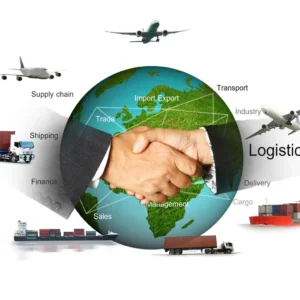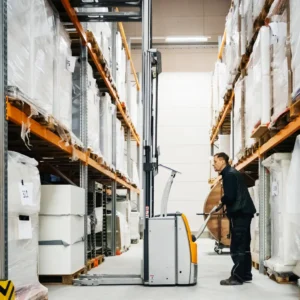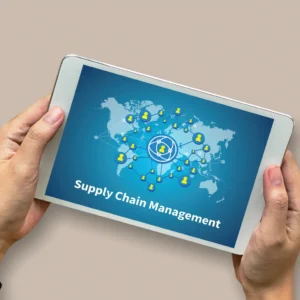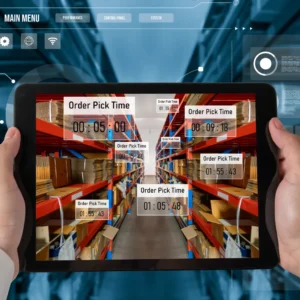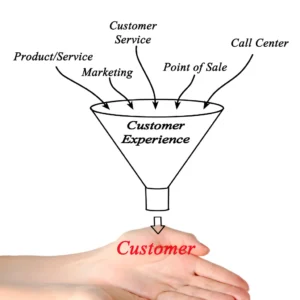
Navigating Compliance
AI Tools Transforming Logistics for Compliance and Regulatory Support in the Industry Evolution
In the ever-evolving logistics industry landscape, the integration of cutting-edge technologies is imperative for efficient operations and regulatory compliance. AI Tools for Compliance and Regulatory Support in the Logistic Industry have emerged as indispensable assets, leveraging artificial intelligence to streamline complex processes.
From Automated Compliance Checks and Telematics for Fleet Tracking to License and Permit Management and Trade Agreement Compliance Checkers, these tools harness machine learning, natural language processing, and image recognition to navigate intricate regulatory frameworks.
Integrating AI tools ensures adherence to regulations and positions organizations as pioneers in IT and AI within the dynamic logistics sector.
Table of Contents

Arindam Roy
An Automation Consultant with 25+ years of IT Experience
5 AI Tool ideas for Compliance and Regulatory Support
The Transportation and Logistics industry faces numerous compliance and regulatory challenges, and leveraging AI can significantly streamline and enhance these processes. Here’s an elaboration on each of the tools you’ve identified:
Automated Compliance Checks:
- AI-Powered Auditing: Use machine learning algorithms to automate the auditing process for shipments and transactions. This can include checking if shipments comply with international and local regulations, ensuring correct labelling, and confirming adherence to transportation standards.
- Real-time Monitoring: AI can continuously monitor real-time shipments and transactions, identifying potential compliance issues as they arise. This helps companies address problems promptly, reducing the risk of fines or delays.
License and Permit Management:
- AI-Driven License Renewal Alerts: Implement AI algorithms to track license and permit expiration dates. The system can send automated alerts well in advance, ensuring that companies renew their licenses and permits on time to avoid disruptions in operations.
- Document Verification: Use AI to verify the authenticity of licenses and permits by analyzing document images. This can help prevent the use of expired or fraudulent documents.
Customs Documentation Automation:
- Natural Language Processing (NLP) for Documentation: Implement NLP algorithms to understand and generate customs documentation. This can streamline the creation of accurate and compliant customs documents, reducing manual effort and minimizing errors.
- Image Recognition for Document Verification: Use AI-powered image recognition to verify that the provided documents match the required standards, ensuring that the customs documentation is complete and correct.
Regulatory Change Alert System:
- Automated Regulatory Monitoring: Utilize AI to monitor regulatory changes globally. The system can analyze regulatory updates and automatically update internal processes and documentation to ensure ongoing compliance.
- Customizable Alerts: Allow users to customize their alert preferences based on specific regions, modes of transportation, or types of goods. This ensures that businesses are only notified of changes relevant to their operations.
Trade Agreement Compliance Checker:
- AI-Powered Trade Agreement Analysis: Implement AI algorithms to analyze trade agreements and determine the impact on specific shipments. This tool can help businesses take advantage of preferential tariffs and comply with complex trade agreement rules.
- Scenario Analysis: Allow users to model various scenarios to evaluate the potential impacts of trade agreement changes on their operations. This helps businesses proactively adjust their strategies to optimize trade benefits.
Implementing these AI tools in the Transportation and Logistics industry can increase efficiency, reduce compliance risks, and improve overall operational performance. Additionally, it allows businesses to stay agile in the face of evolving regulatory landscapes.
Automated Compliance Checks Tool
Business Knowledge Requirements:
- Regulatory Expertise:
- In-depth knowledge of international and local regulations governing shipments, trade, and transportation.
- Understanding the intricacies of labelling, documentation, and transportation standards compliance requirements.
- Audit Processes:
- Expertise in audit processes, including identifying compliance issues, categorizing violations, and determining appropriate corrective actions.
- Legal understanding of the implications of non-compliance and regulatory breaches.
- Industry-Specific Knowledge: Familiarity with the unique challenges and nuances of the logistics industry, including variations in regulations across different regions.
Software Requirements:
- Machine Learning Algorithms:
- Development of sophisticated machine learning models capable of analyzing diverse data sets to identify compliance issues accurately.
- Continuous refinement of algorithms based on evolving regulations and industry standards.
- Real-time Monitoring System: Implement a robust real-time monitoring system that continuously tracks shipments and transactions, providing immediate alerts for potential compliance issues.
- User Interface for Compliance Managers: Creating an intuitive and user-friendly interface for compliance managers to review audit results, monitor real-time alerts, and take necessary actions.
Hardware Requirements:
- Server Infrastructure: Adequate computing power and storage to process and store large volumes of data generated by compliance checks and real-time monitoring.
Integration Requirements to Existing Toolset:
- ERP and Logistics Systems Integration: Seamless integration with existing Enterprise Resource Planning (ERP) systems and logistics platforms to access relevant business data for comprehensive compliance checks.
- Customs Declaration Integration: Integration with customs declaration systems to cross-verify compliance information during the audit process.
Training Required for Existing Staff:
- Regulatory Compliance Training: Training sessions to familiarize compliance and logistics staff with the automated compliance tools and the specific regulations applicable to their operations.
- System Usage Training: Instruction on how to use the AI-powered tool, interpret results, and take corrective actions when needed.
Challenges and Workarounds in Implementing the Tool:
- Data Quality and Standardization:
- Challenge: Inconsistent or poor-quality data affecting the accuracy of compliance checks.
- Workaround: Implement robust data quality checks, standardize data formats, and collaborate with partners for data consistency.
- Regulatory Changes:
- Challenge: Frequent changes in regulations impacting the effectiveness of pre-built compliance models.
- Workaround: Establish a system for regular updates and maintenance to accommodate regulatory changes promptly.
- User Acceptance:
- Challenge: Resistance from staff in adopting automated compliance tools due to concerns about job security or distrust in automation.
- Workaround: Develop a comprehensive change management strategy, emphasizing the benefits of automation in accuracy and efficiency.
Similar Tools Already Available in the Market:
- WiseTech Global’s CargoWise: Offers a comprehensive logistics platform with built-in compliance checks and real-time monitoring capabilities.
Cost and Benefit Analysis:
- Costs:
- Development Costs: Investment in AI development, including hiring data scientists, software engineers, and compliance experts.
- Integration Costs: Resources required for seamless integration with existing ERP, logistics, and customs systems.
- Training Costs: Budget for training staff on using the AI tools, understanding compliance results, and adapting to the new automated processes.
- Benefits:
- Reduced Fines and Penalties: Avoidance of fines and penalties through accurate and timely compliance checks.
- Operational Efficiency: Streamlined audit processes and real-time monitoring enhance operational efficiency.
- Improved Risk Management: Proactively identifying compliance issues and real-time alerts lead to better risk management.
Recommendation: Integrate with Similar Available Products
Integration is recommended considering the existing tools AI Tools for Compliance and Regulatory Support in the Logistic Industry in the market, such as TradeLens and CargoWise.
License and Permit Management Tool
Business Knowledge Requirements:
- Regulatory Compliance Expertise: In-depth understanding of the diverse regulatory landscape governing licenses and permits in the logistics industry, encompassing regional, national, and international regulations.
- License Renewal Processes: Knowledge of the procedures and timelines associated with license and permit renewals to implement AI-driven renewal alerts effectively.
- Document Verification Standards: Familiarity with the authentication and verification standards for licenses and permits, including recognition of valid document features and security measures.
Software Requirements:
- AI Algorithms for Expiry Tracking: Development of AI algorithms capable of tracking license and permit expiration dates, sending timely renewal alerts based on predefined timelines.
- Document Image Analysis AI: Implementing AI models for document image analysis allows the system to verify the authenticity of licenses and permits by extracting relevant information from images.
- Automated Alert System: A computerized alert system will notify relevant personnel about upcoming renewals via email, SMS, or the organization’s communication channels.
Hardware Requirements:
- Server Infrastructure: Adequate computing resources to support the processing power required for AI algorithms, especially during peak periods of license renewals.
Integration Requirements to Existing Toolset:
- Integration with ERP Systems: Seamless integration with existing Enterprise Resource Planning (ERP) systems to access relevant data, including license renewal dates and historical compliance records.
- Communication Platform Integration: Integration with communication platforms ensures the automated alert system can send notifications to the proper personnel seamlessly.
Training Required for Existing Staff:
- System Usage Training: Training sessions to familiarize staff with the License and Permit Management tool, including interpreting renewal alerts and utilizing the document verification feature.
- Document Verification Skills: Instruction on recognizing key features and security measures in licenses and permits during document verification.
Challenges and Workarounds in Implementing the Tool:
- Document Quality Variability:
- Challenge: Variability in the quality and format of documents submitted for verification.
- Workaround: Implement advanced image processing techniques to enhance the system’s ability to extract information from diverse document formats.
- Integration Complexity:
- Challenge: Integrating the tool seamlessly with existing ERP systems and communication platforms.
- Workaround: Develop standardized APIs, conduct thorough testing, and collaborate closely with system vendors for compatibility.
- User Adoption:
- Challenge: Ensuring staff actively engage with the system and promptly respond to renewal alerts.
- Workaround: Implement a change management strategy, emphasizing the importance of compliance and operational continuity.
Similar Tools Already Available in the Market:
- LicenseHQ: Offers license management solutions with renewal tracking and compliance management features.
- Intellovations License & Permit Software: A comprehensive license and permit management system with alert functionalities for renewals.
Cost and Benefit Analysis:
- Costs:
- Development Costs: Investment in AI development, including hiring data scientists, software engineers, and compliance experts.
- Integration Costs: Resources required for seamless integration with existing ERP and communication systems.
- Training Costs: Budget for training staff on using the License and Permit Management tool, interpreting renewal alerts, and conducting document verifications.
- Benefits:
- Avoidance of Disruptions: Timely renewal alerts help avoid disruptions in operations due to expired licenses or permits.
- Enhanced Compliance: Improved compliance with regulatory requirements through automated tracking and verification processes.
- Fraud Prevention: Reduction in the use of expired or fraudulent documents through AI-based document verification.
Recommendation: Integrate with Similar Available Products
Integration is recommended considering the existing tools AI Tools for Compliance and Regulatory Support in the Logistic Industry like LicenseHQ or Intellovations is recommended.
Customs Documentation Automation Tool
Business Knowledge Requirements:
- Customs Regulations Expertise: In-depth knowledge of international and local customs regulations governing shipment documentation requirements.
- Documentation Standards: Understanding the standards and formats required for customs documentation to ensure compliance.
- Trade Compliance Knowledge: Familiarity with trade compliance rules and regulations to incorporate them into the automated documentation processes.
Software Requirements:
- Natural Language Processing (NLP) Algorithms: Development of advanced NLP algorithms capable of understanding and generating customs documentation in various languages and formats.
- Image Recognition AI: Implementing AI-powered image recognition models to verify the completeness and accuracy of provided customs documents.
- User Interface for Document Creation: Creating a user-friendly interface for logistics staff to input necessary information and review generated customs documents.
Hardware Requirements:
- Server Infrastructure: Adequate computing power and storage to support the processing demands of NLP algorithms and image recognition.
Integration Requirements to Existing Toolset:
- ERP and Logistics Systems Integration: Seamless integration with existing Enterprise Resource Planning (ERP) and logistics systems to access relevant shipment information.
- Customs Declaration Systems Integration: Integration with customs declaration systems to ensure the synchronization of customs documentation with the shipping process.
Training Required for Existing Staff:
- Tool Usage Training: Training sessions to familiarize logistics staff with the Customs Documentation Automation tool, including inputting data and reviewing generated documents.
- Understanding NLP Output: Instruction on understanding and interpreting the output of NLP algorithms, especially for complex customs documentation.
Challenges and Workarounds in Implementing the Tool:
- Language and Format Variability:
- Challenge: Customs documents may come in various languages and formats.
- Workaround: Develop robust NLP algorithms capable of handling multilingual input and various document formats.
- Document Quality Assurance:
- Challenge: Ensuring that AI-powered image recognition accurately verifies the quality and completeness of uploaded documents.
- Workaround: Implement a feedback mechanism for users to flag potential issues and improve the image recognition model iteratively.
- Integration Complexity:
- Challenge: Integrating the tool seamlessly with existing ERP, logistics, and customs systems.
- Workaround: Develop standardized APIs, conduct thorough testing, and collaborate closely with system vendors for compatibility.
Similar Tools already available in the market:
- BluJay (now e2open) Solutions Customs Management: Offers customs management solutions with features for document creation and compliance checks.
Cost and Benefit Analysis:
- Costs:
- Development Costs: Investment in AI development, including hiring NLP experts, image recognition specialists, and software engineers.
- Integration Costs: Resources required for seamless integration with existing ERP, logistics, and customs systems.
- Training Costs: Budget for training staff on using the Customs Documentation Automation tool and understanding the NLP output.
- Benefits:
- Reduced Manual Effort: Automation streamlines the customs documentation process, reducing manual effort and minimizing errors.
- Increased Compliance: AI-driven verification ensures that customs documentation is accurate and compliant with regulatory standards.
- Efficiency Gains: Faster document creation and verification contribute to overall operational efficiency in the logistics workflow.
Recommendation: Integrate with Similar Available Products
Integration is recommended considering the existing tools AI Tools for Compliance and Regulatory Support in the Logistic Industry like BluJay Solutions or Amber Road is recommended.
Regulatory Change Alert System
Business Knowledge Requirements:
- Global Regulatory Landscape Understanding: In-depth knowledge of the diverse international and local regulations impacting the logistics industry, including trade, customs, and transportation regulations.
- Logistics Operations Awareness: Understanding logistics operations to tailor the Regulatory Change Alert System to the specific needs and nuances of the industry.
- Legal Compliance Expertise: Familiarity with legal compliance requirements, including how regulation changes impact documentation, processes, and overall logistics operations.
Software Requirements:
- AI for Regulatory Monitoring: Development of advanced AI algorithms capable of monitoring and interpreting regulatory changes globally, ensuring accurate and timely updates.
- Customizable Alert System: Develop a customizable alert system enabling users to set preferences based on regions, modes of transportation, and types of goods.
- User Interface for Preferences: Creating an intuitive user interface to customize alert preferences and access relevant information about regulatory changes.
Hardware Requirements:
- Server Infrastructure: Adequate computing power and storage to support monitoring global regulatory changes and storing historical data.
Integration Requirements to Existing Toolset:
- Integration with ERP Systems: Seamless integration with existing Enterprise Resource Planning (ERP) systems to update internal processes and documentation automatically.
- Logistics Platform Integration: Integration with logistics platforms ensures the Regulatory Change Alert System aligns with and complements existing operational processes.
Training Required for Existing Staff:
- Tool Usage Training: Training sessions to familiarize staff with the Regulatory Change Alert System, including how to customize alert preferences and interpret system-generated alerts.
- Understanding Regulatory Impacts: Instruction on how regulatory changes may impact internal processes, documentation, and overall logistics operations.
Challenges and Workarounds in Implementing the Tool:
- Data Quality and Accuracy:
- Challenge: It is essential to ensure that the data sources providing information about regulatory changes are accurate and reliable. This will help in avoiding any potential errors or misinformation.
- Workaround: Implement robust data validation processes, cross-reference information from multiple sources, and leverage machine learning for data accuracy improvement.
- Customization Complexity:
- Challenge: Designing a user-friendly customization system that accommodates the diverse preferences of logistics professionals.
- Workaround: Conduct user testing, gather feedback, and iteratively improve the customization interface for user satisfaction.
- Real-time Updating:
- Challenge: Ensuring the Regulatory Change Alert System provides real-time updates to keep pace with rapidly changing regulatory landscapes.
- Workaround: Implement a robust and scalable system architecture, leverage cloud-based solutions for agility, and prioritize real-time data feeds.
Similar Tools Already Available in the Market:
- Thomson Reuters Regulatory Intelligence: Offers a comprehensive regulatory intelligence platform for monitoring global regulatory changes.
- Compliance.ai: Provides an AI-driven platform for regulatory change management and compliance monitoring.
Cost and Benefit Analysis:
- Costs:
- Development Costs: Investment in AI development, including hiring data scientists, software engineers, and regulatory compliance experts.
- Integration Costs: Resources required for seamless integration with existing ERP and logistics systems.
- Training Costs: Budget for training staff on using the Regulatory Change Alert System and understanding the impact of regulatory changes.
- Benefits:
- Ongoing Compliance: Ensures ongoing compliance by automatically updating internal processes and documentation in response to regulatory changes.
- Efficiency Gains: Streamlines operations by providing timely alerts and minimizing the manual effort required to track and interpret regulatory updates.
- Customization for Relevance: Allows businesses to focus on changes relevant to their operations, reducing information overload and improving the relevance of alerts.
Recommendation: Integrate with Similar Available Products
Integration is recommended considering the existing tools, such as AI Tools for Compliance and Regulatory Support in the logistics industry, like Thomson Reuters Regulatory Intelligence or Compliance.ai.
Trade Agreement Compliance Checker
Business Knowledge Requirements:
- Trade Agreement Expertise: In-depth knowledge of international trade agreements, including tariff structures, rules of origin, and compliance requirements.
- Logistics and Supply Chain Understanding: Understanding logistics and supply chain operations to align trade agreement analysis with specific shipment characteristics and requirements.
- Legal Compliance Awareness: Familiarity with legal compliance standards ensures the Trade Agreement Compliance Checker addresses complex trade agreement rules.
Software Requirements:
- AI Trade Agreement Analysis Algorithms: Development of sophisticated AI algorithms capable of analyzing complex trade agreements to determine their impact on specific shipments.
- Scenario Modeling Software: Implement scenario modelling tools that allow users to simulate and analyze various trade agreement scenarios and their potential impacts.
- User Interface for Scenario Analysis: Creating a user-friendly interface for logistics professionals to input parameters, conduct scenario analysis, and interpret results.
Hardware Requirements:
- Server Infrastructure: Adequate computing power and storage to support the processing demands of AI algorithms, especially during scenario analysis.
Integration Requirements to Existing Toolset:
- Integration with ERP Systems: Seamless integration with existing Enterprise Resource Planning (ERP) systems to access shipment data, trade agreement information, and compliance records.
- Customs Declaration Systems Integration: Integration with customs declaration systems to cross-verify compliance with trade agreement rules during the analysis.
Training Required for Existing Staff:
- Tool Usage Training: Training sessions to familiarize logistics staff with the Trade Agreement Compliance Checker, including how to input data, conduct analyses, and interpret results.
- Interpreting Trade Agreement Impact: Instruction on how changes in trade agreements may impact specific shipments and the necessary adjustments to optimize trade benefits.
Challenges and Workarounds in Implementing the Tool:
- Data Complexity:
- Challenge: Trade agreements involve complex and dynamic data.
- Workaround: Employ advanced data management techniques, ensure data quality, and continuously update algorithms to adapt to changing trade agreement landscapes.
- User Understanding:
- Challenge: Users may need help interpreting the results of complex scenario analyses.
- Workaround: Provide comprehensive training and support materials and implement user-friendly visualization tools to simplify data interpretation.
- Real-time Scenario Analysis:
- Challenge: Providing real-time scenario analysis given the dynamic nature of trade agreements.
- Workaround: Optimize algorithms for efficiency, leverage cloud-based solutions for real-time processing, and provide periodic updates.
Similar Tools already available in the market:
- Amber Road (now e2open) Trade Agreement Management: Offers a platform with features for analyzing and managing compliance with trade agreements.
- Integration Point Trade Agreements (now a part of Thomson Reuters) : Provides a comprehensive trade agreements platform with analysis and compliance management tools.
Cost and Benefit Analysis:
- Costs:
- Development Costs: Investment in AI development, including hiring data scientists, software engineers, and trade compliance experts.
- Integration Costs: Resources required for seamless integration with existing ERP, customs declaration, and logistics systems.
- Training Costs: Budget for training staff on using the Trade Agreement Compliance Checker and understanding the impact of trade agreement changes.
- Benefits:
- Optimized Trade Benefits: Enables businesses to proactively adjust strategies, optimizing trade benefits based on scenario analyses.
- Compliance Assurance: Ensures compliance with complex trade agreement rules, minimizing the risk of penalties and disruptions.
- Operational Efficiency: Streamlines operations by providing insights into potential impacts of trade agreement changes, allowing for proactive adjustments.
Recommendation: Integrate with Similar Available Products
Integration is recommended considering the existing AI tools for compliance and regulatory support in the logistics industry, like Amber Road or Integration Point.
Conclusion on AI tools for Compliance and Regulatory Support in transportation and logistics
In conclusion, the development of AI Compliance and Regulatory Support tools, including Automated Compliance Checks, Telematics for Fleet Tracking, License and Permit Management, Automated Compliance Checks, and Trade Agreement Compliance Checkers, is pivotal for enhancing efficiency, ensuring compliance, and optimizing operations within the transportation and logistics industry. These advanced tools use machine learning, natural language processing, and image recognition to tackle complex regulatory challenges.
Recognizing the intricacies of the logistics sector and integrating with existing, proven solutions emerges as a pragmatic approach. Established tools like Geotab, Samsara, LicenseHQ, BluJay Solutions, Thomson Reuters Regulatory Intelligence, and Amber Road have industry-specific expertise, providing a quicker time-to-market, cost-efficiency, and scalability.
The success of these tools relies on comprehensive business knowledge, including logistics operations, regulatory compliance, and trade agreements. Training existing staff is essential for seamless tool adoption, ensuring users can effectively leverage the AI capabilities.
While challenges like data complexity and user understanding need careful consideration, the benefits of these tools include reduced manual effort, enhanced compliance, fraud prevention, operational efficiency, and optimized trade benefits. The cost and benefit analysis underscores the value of investing in these tools to stay competitive, mitigate risks, and align with the organization’s identity as an AI pioneer in the ever-evolving transportation and logistics landscape.
Related Articles
- AI Tools for Predictive Analytics and Business Intelligence
- AI Tools for Sustainability and Green Logistics
- AI Tools for Fleet Maintenance and Monitoring
- AI Tools for Operational Efficiency and Automation
- AI Tools for Supply Chain Visibility and Collaboration
- AI Tools for Order and Shipment Tracking
- AI Tools for Warehouse Management and Automation
- AI Tools for Route Optimization and Planning
- AI Tools for Risk Management and Security
- AI tools in the Transportation and Logistics industry


